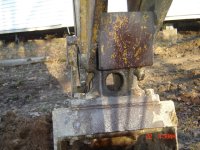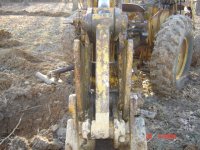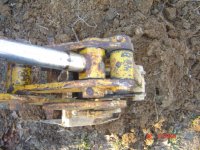RedDirt
Gold Member
- Joined
- Dec 4, 2007
- Messages
- 469
- Location
- Northern Idaho
- Tractor
- Kubota BX23, Wards 16HP HST Garden Tractor, (previous) D2 Logging Cat
I guess I AM compulsive. Now its way past my bedtime but I couldn't let this subject die without some workable conclusion. I think the following would work. I don't know if I will build it or just do as stated above.
I went back to my original design. But instead of the ejector flap being stationary I made it pivot this time and devised a catch and release lever. This is pretty straightforward and I like it for simplicity.
Bucket in dig attitude
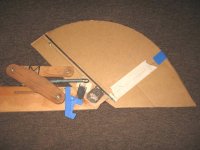
Detail of catch & release latch. Flap and release catch are spring tensioned. The flap rests against the back of the bucket. If there is a recalcitrant load in the buck do a full curl to capture the ejector flap. The flap is retained in this position while the bucket is opened and the material is dumped. This occurs just before full open bucket. Then proceed to full open bucket, the release latch is activated and the flap spring returns to rest against the bucket back.
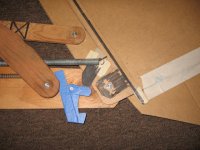
Ejector flap engaging catch
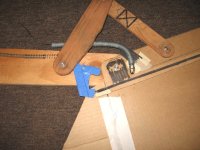
Open bucket and dump

Open bucket fully to activate flap release
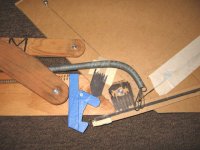
Flap spring returning to rest position
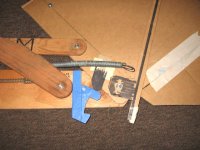
So there we go. A fairly simple design that should work without too much fussing. This bucket is a custom design that is almost true radius except for a straight section the last 30 degrees or so to help out the angle of attack when digging. Maybe the design principle is adaptable to existing buckets, I'm not sure.
It is doubtful I'll build this bucket but if anyone does please post your construction and digging results so we can see.
I went back to my original design. But instead of the ejector flap being stationary I made it pivot this time and devised a catch and release lever. This is pretty straightforward and I like it for simplicity.
Bucket in dig attitude

Detail of catch & release latch. Flap and release catch are spring tensioned. The flap rests against the back of the bucket. If there is a recalcitrant load in the buck do a full curl to capture the ejector flap. The flap is retained in this position while the bucket is opened and the material is dumped. This occurs just before full open bucket. Then proceed to full open bucket, the release latch is activated and the flap spring returns to rest against the bucket back.

Ejector flap engaging catch

Open bucket and dump

Open bucket fully to activate flap release

Flap spring returning to rest position

So there we go. A fairly simple design that should work without too much fussing. This bucket is a custom design that is almost true radius except for a straight section the last 30 degrees or so to help out the angle of attack when digging. Maybe the design principle is adaptable to existing buckets, I'm not sure.
It is doubtful I'll build this bucket but if anyone does please post your construction and digging results so we can see.
Last edited:

